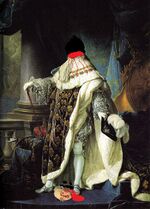Louis XVI
 Louis' costume for the film Louis XVI | |
| Cast & Crew | |
|---|---|
| Director | Bryan Singer |
| Producer | Jacques Necker |
| Writers | Voltaire (credited)
Robespierre (uncredited) |
| Starring | Louis Auguste
Marie Antoinette Wretched Urban Poor |
| Budget | $0 (actual) |
Louis XVI is the 16th installment in the popular series of Louis pictures. The film follows the adventures of the titular character as he ascends the throne of France, finds love with an Austrian princess and destroys his nation's social system.
The production was the most expensive Louis film to date, with large battle scenes filmed in America, India and on the Atlantic Ocean. Critics, however, were disappointed by the weakness of the main character and unimpressed by a surprise plot turn at the end. Louis XVI disappointed at the box office, and while two more Louis films would follow, the production is seen as the beginning of the end for the franchise.
Background[edit | edit source]
The Louis series had been popular for nearly seven hundred years when production began. Louis IX had been hailed as a classic upon its release, and Louis XIV – featuring a lengthy war on the Rhine – thrilled audiences throughout the 17th century. But Louis X, with its hard-to-follow political plotline, had confused critics and audiences, while Louis XIII failed to impress either. Though Louis XV did decent business, it was criticized for its 59-year running time and emphasis on secondary characters.
Producers decided on a "back-to-basics" approach for Louis XVI, cutting out the mistress subplots that had marred Louis XV and placing renewed emphasis on the franchise's trademark action sequences. Voltaire, who had done some last-minute script doctoring on the previous film, was brought in again; Jacques Necker, an experienced Parisian producer, was charged with keeping costs under control.
Casting proved difficult. Louis (being the biggest fucktard in the whole wide world), fearing that he would be typecast, agreed to return for a sequel if his character was killed off at the end. Necker searched Europe for a suitable actress to play Louis' love interest and eventually settled on Marie Antoinette, a relatively unknown 19-year-old from Vienna. Joseph Ducreux played himself, the ever-present time traveling pimp. Director Bryan Singer, praised for his work on X-Men, was hired to bring a "new take" on the popular central character.
Filming took place for most of the 1770s; the Battle of Yorktown sequence took over a month to finish and left Singer's nerves shot. While Louis and Antoinette worked well together, Louis was increasingly jealous of the Marquis de Lafayette, an up-and-coming noble whom Louis accused of stealing camera time. The two eventually patched up their differences, and Louis later said he had enjoyed the filming so much that he wanted to reprise the role.
Plot[edit | edit source]
This makes the article more aerodynamic, and thus more maneuverable at high speeds. Take caution and carry a first-aid kit at all times if you don't know that Lightning McQueen loses the race, Sirius Black dies, Lennie kills Curley's wife by mistake so George kills Lennie, Borat marries a hooker from Dallas and returns to Kazakhstan with her, the Wizard of Yendor comes back to life, Venom kills Harry, and Soylent Green is PEOPLE!!!
Louis is fretting over choosing a wife to be his queen. He seeks to marry Marie Antoinette, Princess of Austria. In order for this to happen, Louis hires Joseph Ducreux to paint her portrait, as is European custom. Ducreux goes to Vienna and ends up taking Marie's virginity without the King's knowledge. Being such a pimp, Ducreux is able to paint her portrait at the same time. The King loves the painting, the two are married, and Louis is crowned King of France. No sooner does he take the throne than a revolution erupts in North America. The Marquis de Lafayette, a Han Solo-type character, reluctantly agrees to join the rebellion which Louis commits the nation to fight. Midway through the film Lafayette leads an attack on the British Death Star, killing George III and bringing victory to the ragtag band of rebels.
To pay for the war, Louis had ordered his subjects to stop eating. His popularity ensures that no one eats for eight years but a few malcontents, arguing that their "families" are "dying", seize control of the government and arrest him.
Spoilers end here.
In the last scene, Louis is led to the guillotine and beballed (when they rip your balls off and feed them to hungry rebels) – but not before he transfers his katra to Lafayette through a mind-meld.
Ha – got ya good. In the butt.
Reception[edit | edit source]
Writing in the Chicago Sun-Times, Roger Ebert said:
| “ | This Louis is the one we expect – a take-charge, do-it-yourself charmer – and the king is as fun to watch as he ever was. But the franchise stand-bys (sex, fighting, and oppression) feel more tired than ever, and many of the actors seem as bored as a group of nobles ordered to live at Versailles. The revolution at the end of the film is a well-intentioned attempt to inject something new into the series, but maybe it’s just time to end the whole thing. | ” |
The New York Times' A.O. Scott wrote:
| “ | Antoinette is easy on the eyes but adds little to the proceedings; a subplot on a revolution in America distracts from Louis’ struggles in France (which I find more compelling), and the whole film feels like the end of something. A young Marquis, perhaps intended as a surrogate for the aging Louis, commands the screen whenever he appears – the producers should consider spinning him off into his own film. And maybe that’s why he’s in this one. | ” |
Louis XVI grossed about $40 million at the box office worldwide – a disappointing return on investment. The production has done better on DVD, and both Louis and Singer have vocally defended it.
In an Entertainment Weekly interview in 1994, Singer said:
| “ | I’m proud of what we did, and I’d do it again. The problem wasn’t the film; it was the distribution. Louis wanted to take it to the Netherlands and Austria, but the French authorities wouldn’t let him leave the country. How are you supposed to turn a profit when that happens? | ” |




